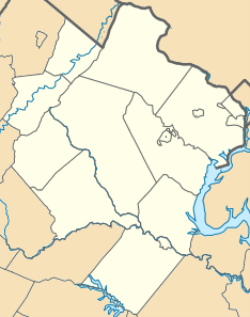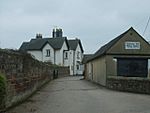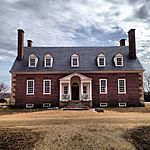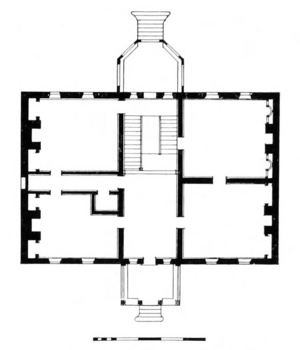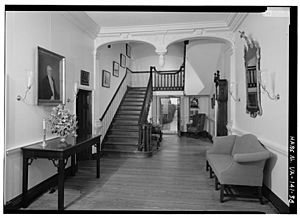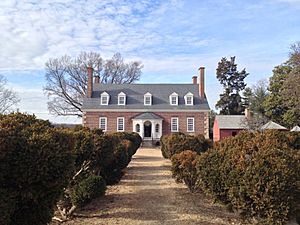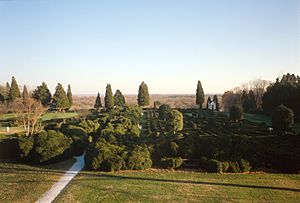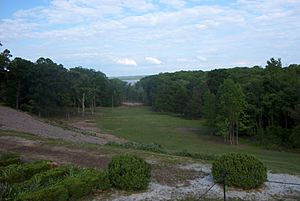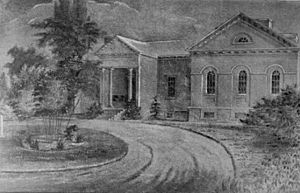Gunston Hall facts for kids
|
Gunston Hall
|
|
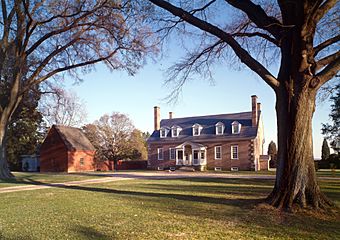
View of Gunston Hall from the northwest
|
|
| Nearest city | Lorton, Virginia |
|---|---|
| Area | 555.7 acres (224.9 ha) |
| Built | 1759 |
| Architect | George Mason; William Buckland |
| Architectural style | Georgian |
| NRHP reference No. | 66000832 |
Quick facts for kids Significant dates |
|
| Added to NRHP | October 15, 1966 |
| Designated NHL | December 19, 1960 |
Gunston Hall is a beautiful old house from the 1700s, located near the Potomac River in Mason Neck, Virginia, United States. It's a great example of Georgian architecture, which was popular at the time. This large house was built between 1755 and 1759. It was the main home and center of a huge farm, called a plantation, that was about 5,500 acres (22 km²) big.
Gunston Hall was the home of George Mason, one of the important Founding Fathers of the United States. He was a key person in creating the American government. His home is also not far from Mount Vernon, which was George Washington's home.
The inside of Gunston Hall was designed mostly by William Buckland. He was a skilled carpenter and joiner who came from England as an indentured servant. This meant he worked for the Masons for a few years to pay for his trip to America. Buckland later became a famous architect, designing many important buildings in Virginia and Maryland. He and another indentured servant, William Bernard Sears, are thought to have created the fancy wooden decorations inside the house.
Gunston Hall's interior design is special because it mixes different styles like rococo (a fancy, curvy style), chinoiserie (Chinese-inspired designs), and Gothic (a style with pointed arches and detailed carvings). This was unusual for Virginia back then, as most homes had simpler decorations. While chinoiserie was popular in Britain, Gunston Hall is the only known house in colonial America to have this kind of decoration.
In 1792, Thomas Jefferson visited Gunston Hall for the last time to be with George Mason as he passed away. After Mason's death, the house was lived in by private families for many years. In 1868, a famous person who worked to end slavery, Colonel Edward Daniels, bought it. Today, Gunston Hall is a museum owned by the Commonwealth of Virginia. It is open to everyone to visit. The National Society of The Colonial Dames of America helps run the museum with the state. The house and its land were named a National Historic Landmark in 1960 because of their connection to George Mason.
Contents
History of Gunston Hall
How Gunston Hall Got Its Name
The Mason family came from a place called Gunstone in England. Like many people from that area, they supported the King during the Wars of the Three Kingdoms (1642-1651). After the King's side lost a big battle in 1651, Philip Mason I moved to Virginia. His cousin, Gerard Fowke, also moved there. Gerard's family home was called Gunstone Hall, and that's where George Mason's house got its name.
Building the House
William Buckland signed a contract with Thomson Mason, George Mason's brother, on August 4, 1755. This was just after Buckland finished his training as an apprentice. In exchange for a free trip to Virginia, a place to live, food, and a yearly payment, Buckland agreed to work as a carpenter and joiner for the Masons for four years.
When Buckland arrived in November, the outside walls of Gunston Hall were probably already finished. Buckland likely designed the portico (a porch with columns) that faces the garden. He also probably designed much of the inside of the house. The detailed carvings inside the mansion were likely done by both William Buckland and William Bernard Sears. Buckland probably drew the designs, and Sears likely did the actual carving of the wood. They also probably worked together on much of the original furniture. It was common for English architects back then to design furniture as well as buildings.
Later Years of the House
The mansion stayed in the Mason family until 1867. From 1868 to 1891, it was owned by Edward Daniels. He was a newspaper publisher and politician from Virginia who had fought for the Union side in the American Civil War. He was also a strong supporter of ending slavery.
In 1912, a retired business executive named Louis Hertle bought Gunston Hall. His second wife, Eleanor Daughaday, was a member of The National Society of The Colonial Dames of America. They worked hard to bring the mansion back to its original look and hosted many important guests. In 1949, Louis Hertle left the property to the Commonwealth of Virginia in his will. He wanted it to be a museum run by The National Society of The Colonial Dames of America.
Pamela Cunningham Copeland was a very important person in restoring Gunston Hall. She was a horticulturist (someone who studies and grows gardens) and worked to preserve historic places. As the first leader of the Board of Regents for Gunston Hall, she helped restore the historic gardens. She also helped get old furniture for the house and brought Mason family members together to support the historic site. She even helped write a book about the Mason family in 1975.
Gunston Hall's Architecture
First Floor Design
The front of Gunston Hall faces northwest. The first floor of the house has a long hallway, called a central passage, that goes from a door in the front to a door in the back. A staircase goes up from this hallway. On one side of the hallway, there's a main bedroom in the front and a smaller living room in the back. Between these two rooms is a smaller hallway that leads to another staircase. The official website for Gunston Hall says that on the other side of the house, there's a living room in the front and a dining room in the back. However, another historical record says the dining room is in the front and a special "palladian room" is in the back.
The central passage has six columns, called Doric-style pilasters, along its sides. A double arch with a carved pine cone separates the front part of the hallway from the back. In the front, there are four doors facing each other, but one is a fake door to make everything look even. The front of the hall has wallpaper, while the back has painted wood panels.
The main bedroom was a private room and was not as fancy as the public rooms. Near the end of George Mason's life, it was painted a bright emerald green, which was a popular color. The windows had special shutters that could slide into the walls. These are thought to be the only windows in the house that had curtains when Mason lived there.
The smaller living room was also private and decorated simply. The walls were painted a neutral grey color. Above the fireplace was a special mantelpiece with a split pediment (a decorative triangle shape). When Mason lived there, this space probably held a painting or a mirror. On either side of the fireplace were deep shelves called beaufats, used to store and show off dishes. They had doors to keep valuable items safe.
The room on the western side (sometimes called the parlor or dining room) was a public room with very fancy decorations. The walls are painted a yellow-orange color, and the woodwork has a Chinese style. The fireplace wall has a mantel decorated with fretwork (patterns made of intersecting lines) and scalloped moldings that look like pagodas (Chinese towers). There are also pine cone decorations on top. Above the doors are similar decorations, which might have held Chinese porcelain vases or figures. The two long windows have scalloped tops decorated with fretwork. When Mason lived there, three of the walls probably had wallpaper. In the 1700s, Chinese-style design was popular in Great Britain. However, the Gunston Hall museum doesn't know of any other rooms in colonial America with this kind of matching Chinese-style woodwork.
The room on the southern side (called the dining room or the palladian room) was also public and the most decorated room in the house. The classical woodwork shows touches of the fashionable rococo design. The fireplace wall has a very fancy chimney breast (the part of the chimney that sticks out into the room). On either side of the fireplace are beaufats, but these shelves are not as deep as the ones in the little parlor and don't have doors. Fancy broken pediments top the chimney breast and the beaufats. The floor was made of carefully matched planks of wood, which was a very expensive feature. Carved patterns that look like eggs and darts surround the black-walnut entry doors. When Mason lived there, painted or decorated paper covered the thin pine panels on the walls. The two windows in this room look out onto Mason's beautiful garden.
Second Floor Layout
Unlike other large houses from the 1700s, the second floor of Gunston Hall is very different from the first floor. A narrow hallway runs across the upper level, leading to seven bedrooms and a storage room. At the top of the main stairs, there's a three-part arch with carved pillars. This arch separates the hallway from a small area that looks down over the staircase. The smaller service staircase comes up on the opposite side of the storage room.
Only the four corner bedrooms on this floor have fireplaces. Their fireplaces and the areas around them have some architectural details. The corner rooms have two or three windows each, while the inner bedrooms only have one window. The walls of the corner bedrooms were painted with more expensive colors, like Prussian blue or verdigris (a greenish-blue color). You could get to the attic through one of the inner bedrooms.
The storage closet, or "lumber room," didn't have a window to the outside. Instead, it got light from a window that faced the stairwell, because there was an outside window above the staircase landing.
Basement Features
Gunston Hall has a basement, which has a main hallway and four rooms, just like the floors above it. Three staircases lead down to the basement. The basement has four brick arches that support the chimneys and nine small windows. In 1975, an old cast-iron stove was found in the basement. The style of the stove suggests it was from the 1700s or early 1800s. Around 1986, a special drainage system was built around the outside of the foundation walls. This helped to reduce standing water in the basement caused by too much moisture in the ground.
Porches of Gunston Hall
The front porch of Gunston Hall is considered William Buckland's most unique design. Its classical look is exactly like a Roman medal showing the Temple of Tyche in Eumeneia, a city in ancient Asia Minor. It's possible Buckland saw this medal or heard about it when he was learning his trade from his uncle, who owned a bookshop. The porch also looks very similar to the porch of Honington Hall in England, which might have inspired Buckland.
Garden and Other Buildings
The garden is located behind the house, on the southern side. It was built on a flat area that used to be a hill and is exactly one acre (about 4,000 square meters) in size. A gravel path runs from the back of the house to the southern edge of the garden. This path was 12 feet (3.7 meters) wide when George Mason lived there, which was the same width as the central hallway inside the house and the porch. Today, the path is narrower because of the large boxwood bushes, which are now about 250 years old. The path ends at a lookout point that extends from the steep edge of the garden. From here, you can see the Potomac River. The Gunston Hall museum website says that the view was even more impressive when Mason lived there because the trees were cleared away. The garden was most likely divided into four rectangles, with more gravel paths running through and around them. To make all the rectangles look the same size from the house, the ones closer to the house were probably shorter than the ones farther away.
The other buildings at Gunston Hall have been rebuilt to look like they did originally. These include a kitchen, a dairy (where milk products were made), a smokehouse (for curing meat), and a laundry building. They show what typical support buildings on an 18th-century plantation would have looked like. George Mason owned about 90 slaves, but we don't know exactly where their homes were located.
Visitors' Center and Museum Shop
The visitors' center shows an 11-minute film called "George Mason and the Bill of Rights." This film helps you learn more about George Mason and his important work.
The museum shop sells souvenirs like books, gift items, soap, food, and toys. It's a great place to find something to remember your visit.
Other Plantations Owned by the Mason Family
Besides Gunston Hall, George Mason owned other large farms called plantations. These included Hollin Hall, Woodbridge, Lexington, and Mason's Island. His son, John Mason, lived in Clermont for part of his life. The Gunston Hall plantation was like a small village, with over a hundred people living and working there.
George Mason gave Hollin Hall to his third son, Thomson Mason, in 1781 and 1786. This land was about 676 acres (2.7 km²) big. Hollin Hall is about 3 miles (4.8 km) southwest of Alexandria. In the late 1700s, it was close to George Washington's Mount Vernon. Thomson Mason was the first Mason family member to live there. Before that, the land was rented out to other people. Woodbridge Plantation was located on the Occoquan River, across from a town called Colchester. There was a ferry there. George Mason left this land to Thomas Mason, his youngest son, in his will in 1792.
Lexington Plantation was originally part of the Gunston Hall Plantation land. Lexington was given to George Mason's first son, George Mason V. The main house at Lexington Plantation was probably built after George Mason V returned from a trip to Europe in 1783.
George Mason III bought Barbadoes Island (which is now called Theodore Roosevelt Island) in 1717. The island then became known as Mason's Island. George Mason gave this island to his fourth son, John Mason, in 1792. Since John Mason always called the island Analostan Island, it became known by that name. In the 1790s, John had a summer home built there. After some money problems, the bank took ownership of the island and John's property in Georgetown in 1833. John Mason then moved to Clermont, a 320-acre (1.3 km²) property he had recently bought, where he lived for the rest of his life.
Legacy of Gunston Hall
Gunston Hall, the home of George Mason, was honored on a 3-cent stamp on June 12, 1958. This was to celebrate its 200th anniversary. The stamp shows the side of the classic brick house that faces the river. George Mason wrote the Virginia Declaration of Rights, which was a very important document. It later helped create the first ten changes, or amendments, to the United States Constitution.
Gunston Hall also gave its name to two ships in the U.S. Navy: the USS Gunston Hall (LSD-5), launched in 1943, and the USS Gunston Hall (LSD-44), launched in 1987. It is also the namesake for Gunston Elementary School in Lorton, Virginia, Gunston Middle School in Arlington, Virginia, and "Gunston," which used to be the athletic mascot for George Mason University.
|
See also
 In Spanish: Gunston Hall para niños
In Spanish: Gunston Hall para niños


